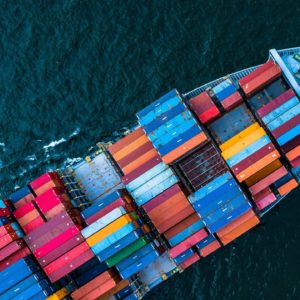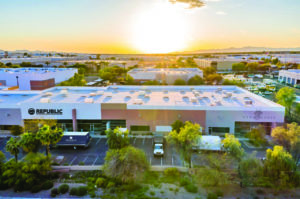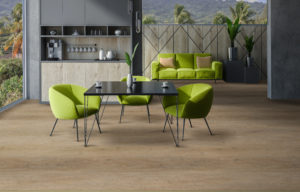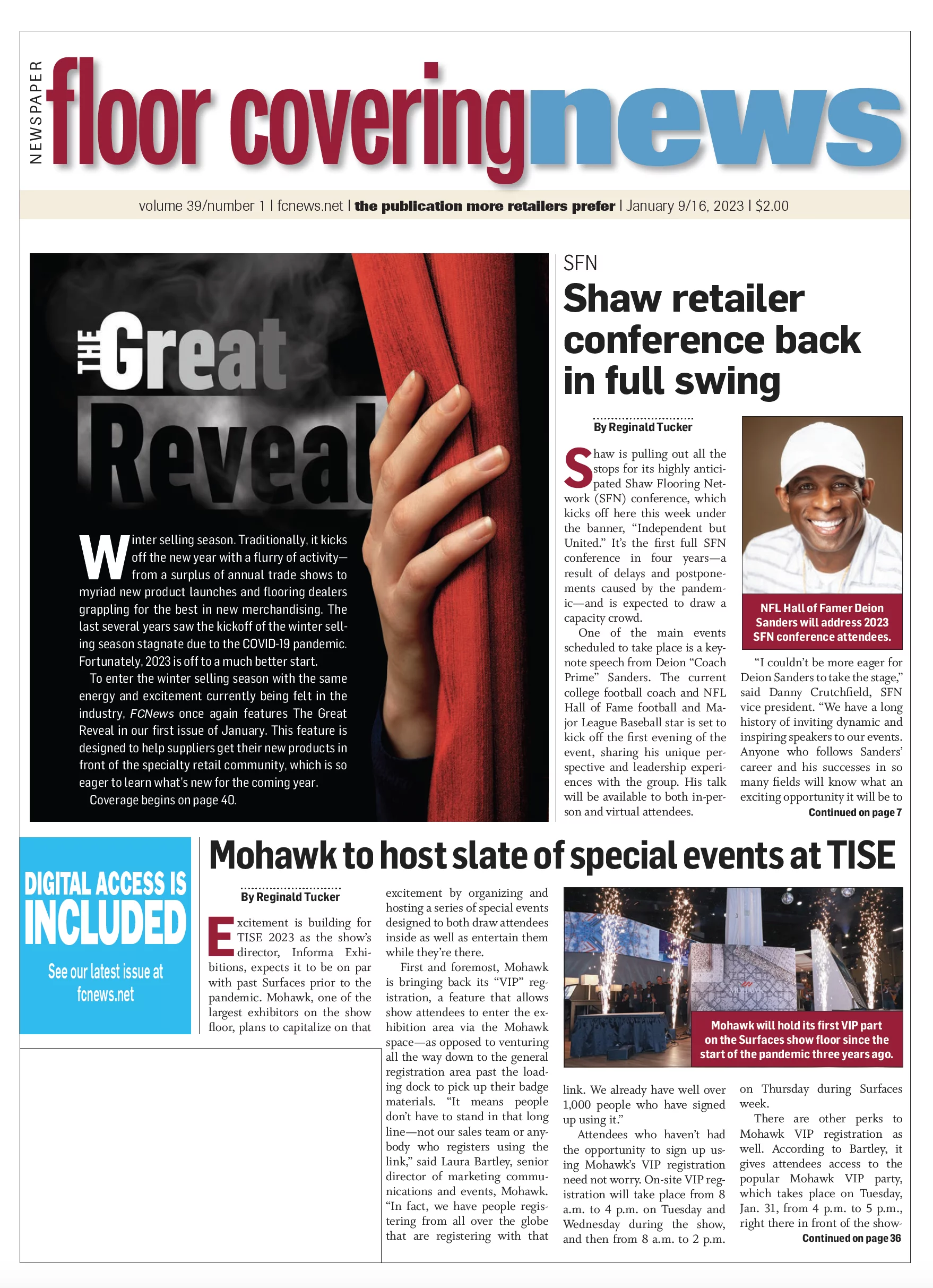Commerce, Calif.—Eight years after launching its brand in the U.S., Republic Floors has become a significant player in the floor covering arena with annual sales approaching $200 million.
What makes this company unique is its unorthodox approach to capturing market share, whether it be controlling its logistics, its approach to being at the forefront of design or a greater number of SKUs than most companies out there.
Republic CEO, Rotem Eylor, recently sat down with FCNews publisher, Steven Feldman, to discuss all that makes the company different.
Logistical advantages

“Most companies’ highest cost is logistics because they need to rent trucks, or maybe they use third-party logistics (3PLs) to bring containers from the port,” Eylor stated. “They have so many other costs. They’re at the mercy of other companies. Those companies—freight and LTL—didn’t raise prices 20% or 30%, whatever their costs increased, but rather doubled or tripled their prices. Freight has tripled from two years ago. There are not enough trucks and drivers. They know supply is limited so they can charge five, six, seven times what they did two years ago. But Republic is prepared with our fleet, our drivers, our licenses. We have our own container chassis. We do everything ourselves. So we have hedged all that.
“Our fleet is close to 100 units—tractors, trucks, etc. We are buying new trucks all the time. We can pick up at the port. We can do everything. We have licenses with the port. We have security clearances. We are a self-sufficient company.
“Another advantage that many people don’t realize: Take the Los Angeles port. There are actually about 50 different sub-ports. Most companies don’t know which sub-ports are good and which are not. Republic knows which ports can get the containers off-loaded quicker. There are certain sub-ports where we have developed good relationships with the person in charge. When you don’t control that, when you’re like 99% of the market and use third-party companies, they use the cheapest ports possible. But with those ports they may not get the container for a week or two. It’s like Russian Roulette. It’s that way with every port in the country.”
Focus on reinvestment
“Because Republic has the financial means, because we have our own R&D department, our own design centers in China and Germany, we invest a lot of money in new designs. And we invest a lot in colors. We have over 300 colors in our showroom. How many companies have that many colors in hard surface in their showroom?
“We can afford to do a lot of unique stuff. It may not always be the smart thing to do, but we want to make a statement. We want to keep our customers in the Republic eco-system where we have anything they want. For example, we tried black five years ago. No one had done black. I knew it would be a niche color, but I wanted to try it. It ended up being a top 10 seller.
“We have a lot of unique stuff in the pipeline. Why? Because we don’t take our profits and put it in our pockets like most companies. We don’t believe in making more money and reducing quality. We put all our money back into the company over and over again. The idea is to get this company to the next level.”
Warehousing capabilities

Republic has consolidated its Southern California operations into a 100,000-square-foot warehouse that previously served as Armstrong’s primary warehouse on the West Coast. The building will also contain a showroom and serve as Republic’s main headquarters with 40-50 employees based here. This is in addition to Republic’s 250,000-square-foot space in Northern California, which is currently being expanded to 500,000 square feet.
Republic is also opening a warehouse in Miami, which will service the entire East Coast. But soon it will be opening another East Coast location further north to service the mid-Atlantic and Northeast. The company also plans to double the size of some existing distribution centers.
Trendsetting design
Republic opened in Germany because it wanted to be trendsetters, according to Eylor. “We wanted to be in the epicenter of the design of flooring worldwide. Milan is the epicenter of trendsetting in clothing. We wanted to understand design. We wanted to understand manufacturing in Europe. We wanted to understand distribution in Europe.
“The idea is to be trendsetters. It’s about how can Republic can be unique. How Republic can be positioned as a worldwide trendsetter.”
Republic has two locations in Germany: corporate offices in Munich and a distribution center next to Dusseldorf. It designs products for the European market there. Then Republic brings over products it believes are appropriate for the U.S. market.
“Traditionally, design starts in Europe and then after two or three years they come to the U.S.,” Eylor explained. “We make the process shorter. For most companies, China serves as a middleman. They are telling American companies what is selling in Europe. Then it takes time to determine which designs will sell in the U.S. We cut the middleman. We learn what’s selling in Europe ourselves. So instead of waiting two or three years to bring it to the U.S. market, it will only be a few months. As things are happening in Europe we will bring it to America. We will create that trend here.”
Eylor claims this is a different system than what people are used to. “I want to be unique. I don’t need to ask China what’s selling well. I want to create my own thing, not just based on color but also microtones. We have this collection of 20 products. They almost look identical, but they are not. For example, widths are different. Europe is more narrow. So if a 7-inch-wide board is selling in Europe, we may make it 9 inches wide for the U.S. market.
“It goes both ways. Right now we are trying to push 9-inch boards in Europe. Same with thickness. In Europe it’s customary to do 3.2mm, 4mm SPC. In laminate, 6mm. Here you see 12mm; 8mm is the minimum. In Europe, they have no idea what’s 12mm. Right now we are trying to push higher-end stuff in Europe: longer and wider planks along with 6mm, 7mm, 8mm SPC. We are creating a new market in Europe that doesn’t exist.
“Take herringbone. That is a European design. That’s what they were doing 100 years ago. It’s still very strong. In the U.S. it was strong 30-40 years ago and now is making a comeback. We are bringing that here. In Europe, the herringbone is mostly 3 inches wide. We are going to bring 5 inches wide but also 3 inches. That doesn’t exist in SPC here.”
Aggressive growth

Republic achieved modest growth of 5% in 2022 to roughly $172 million in sales. For 2023, the company is forecasting 20% growth despite what many believe will be a challenging first half.
Total control = price advantages for dealers
“I’m controlling everything. I’m the designer,” Eylor said. “I’m the manufacturer. I own my container chassis. I own my own fleet. I locked in my fuel prices with a future contract before COVID-19, so we are paying fuel prices from two years ago. We committed to a certain dollar amount that we paid whether we use it or not. We control every process along the way. We even buy our own raw materials from the Emirates for SPC.”
What’s up in wood

In 2022, Republic introduced Fort du France, a more cost-effective line within its Müeller Graf lineup. While Müeller Graf is all Valinge click, Fort du France is tongue and groove because installers were asking for it, according to Eylor. “The cost savings comes from not having to pay the licensing fee for the click system.”
The consumer does not sacrifice anything in the way of quality with Fort du France despite paying about a dollar less than other Müeller Graf products. It is offered in the same colors and clean looks and is also 9/16 of an inch thick. The line is 7-inch wide and random lengths with a 2.5mm top layer.
Republic will soon announce an international distribution agreement with a large wood brand from Europe where it will handle the line in every country where it has set up operations.
The line is visually different from Müeller Graf, whose clean looks resemble Republic’s SPC.
Proactive on price reductions
Republic recently enacted its fifth consecutive price reduction in the market. “We started in September 2021,” Eylor said. “We were the only company to do that. Others started just five months ago. Each price reduction was 5%-7%. So prices today are below what they were when the pandemic began in 2020. We don’t wait for retailers to say, ‘Other companies are reducing prices.’ We started it. We were the leader of price reductions and propelled other companies to do it. We put the pressure on them. We show our customers our loyalty in reducing prices without them asking.”
New for 2023

Republic is introducing Solar Granite, a shiny marble look, at Surfaces in four colors. “Shiny marble is making a comeback,” Eylor said. “There are many challenges in making this. Slip resistance, scratch resistance, consistent shine.
“What makes Solar Granite special? Have you ever seen a product like that in the market? We don’t even have to talk about it. The customer looks at it and says, ‘Wow. Amazing. I want it right now.’ That’s the reaction we get from every account we show it to.”
One difference: There is no attached pad. Rather, there are grooves on the back. This way people can glue it on walls if they want.
Solar Granite is slip resistant because of the materials applied on the finish during the manufacturing process. “All our SPC is highest rated for slip resistance,” Eylor said. “We work with a lot of hotel chains, and the No. 1 issue for them is slip resistance. They don’t need lawsuits.”
Other Surfaces intros:
- Waterproof laminate lines from China and Europe
- 12mm and 14mm SPC
- An SPC that is half the weight of regular SPC called UltraLite; more product in the container allows for reduced cost.
- New colors and sizes across existing collections

